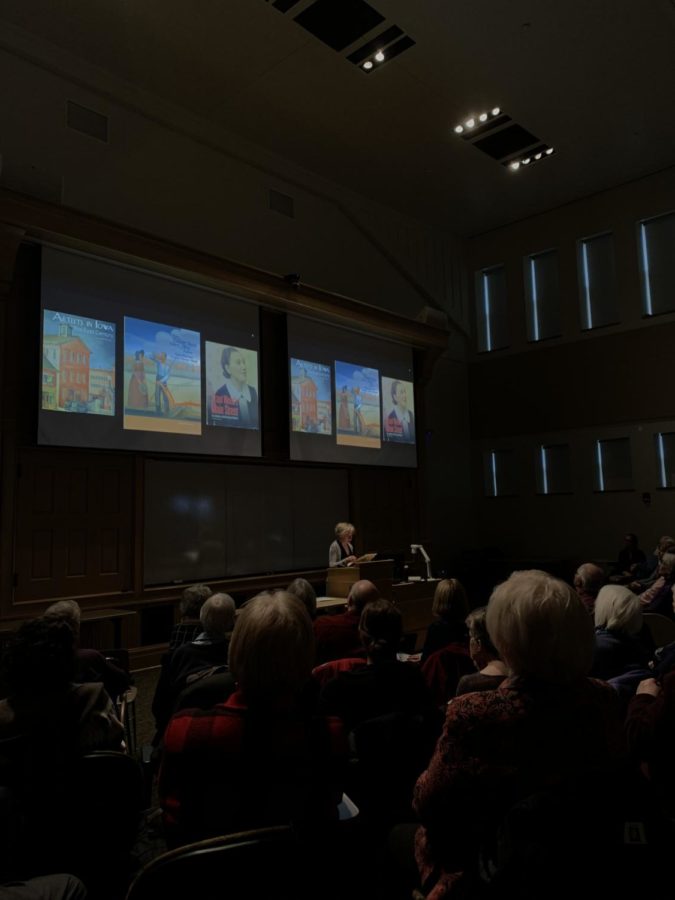Secrets of famous artist Grant Wood discussed in lecture
Sue Taylor, professor emerita of modern art history at Portland State University and author of the newly published novel “Grant Wood’s Secrets” discussed hidden visual motifs and messages within Grant Wood’s art in a lecture.
March 9, 2020
Grant Wood’s secrets were discussed in an author’s lecture on the famous artist and his legacy.
On Monday, Sue Taylor, professor emerita of modern art history at Portland State University and author of the newly published novel “Grant Wood’s Secrets” discussed hidden visual motifs and messages within Wood’s art in a lecture.
The lecture took place in Room 2019 of Morrill Hall. Attendees registered for a seat online, and the event was at capacity before the lecture began.
Taylor began her lecture by honoring Lea Rosson DeLong, an art historian, curator and editor, working mainly in American art of the 1930s and contemporary art among publications for the University Museums of Iowa State.
In her lecture, Taylor explored and analyzed Wood’s iconic and lesser-known artworks and also analyzing subtle yet meaningful symbols in the artist’s artworks.
“Wood repeated secret ‘codewords’ in his artwork,” Taylor said. “He has referenced the green carnation in his artwork, such as the Sentimental Yearner and the Radical. He also portrayed a red handkerchief in his painting ‘The Fruits of Iowa.’”
Taylor then went on to explain the messages that these symbols portrayed, such as how the green carnation was symbolic of homosexual attraction, and hanging a handkerchief out of one’s pocket was a way that gay men communicated who they were interested in sexually. These are just two of the few symbols that Taylor analyzed in Wood’s artwork.
She then explained concepts of masculinity in Wood’s artwork and how he portrayed himself amongst others.
The artist typically dressed in overalls and expressed his love for the Midwest while also consciously utilizing regionalist strategies. He posed as masculine, hiding his homosexuality from his rural community, which is why most art historians believe that he lived as a “double-man,” a term that Taylor used in describing Wood in her lecture.
“Wood came to experience himself as a double-man; he would show himself as a humble farmer and an urbane dandy,” Taylor said when analyzing a portrait of the artist.
In her lecture, Taylor also noted Wood’s precision when it came to painting images of botany and foliage.
“Wood had an interest in flowers that he inherited from his mother; in his easel paintings and in his murals, he always took great care in the specificity in the plants he depicted,” Taylor said.
Examples of this can be seen in Parks Library in Wood’s murals portraying botany.
Much of Wood’s artwork portrays scenes of agriculture, chemical engineering, mechanical engineering, aeronautical engineering, civil engineering, home economics, veterinary science and ceramics. Wood’s murals located in Parks Library are some of the largest that he has created.
The Grant Wood Foyer, located behind Bookends Cafe in Parks Library, is Wood’s agrarian-themed mural, which is titled “When Tillage Begins (Breaking the Prairie).” Another one of Wood’s murals is located in the staircase leading to the upper lobby of the original Parks Library.
These murals were commissioned by former Iowa State President Raymond M. Hughes to plan murals for the library in the 1930s.
The cleaning and restoration of the murals was completed by conservator Margaret Randall Ash in September 1974. Under the university’s system for regular preservation maintenance of artworks, Ivan Hanthorn, former head of the Library’s Preservation Department, removed the accumulation of remodeling dust in 1988.
“As an art historian, we know that the artist doesn’t own all interpretations of the art. New readings accumulate over time, making these works universal,” Taylor said in response to an audience member asking how Wood’s artwork carries such relevance decades after his passing.
After the lecture was an open house event, where lecture-goers could purchase Taylor’s novel “Grant Wood’s Secrets” as well as get the novel signed after the lecture.







